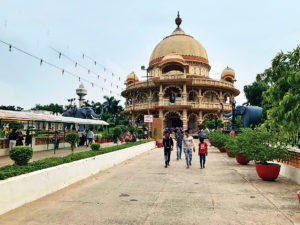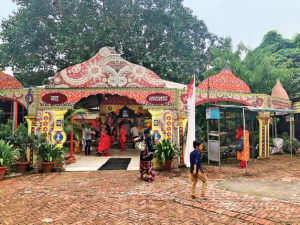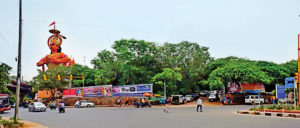The Ravidas temple in Tughlaqabad was demolished on court orders as it was situated in a forest area.
But four other religious structures built in Delhi’s green areas are flourishing
With the Supreme Court ordering the demolition of the 500-year-old Sant Ravidas temple in Tughlaqabad, chaos struck Delhi with thousands of Dalits, including members of the Bhim Army, hitting the roads against the verdict. Meanwhile, other temples and ashrams that were also been built on the green belt in the past, continue to thrive without interventions from any authority or courts.
In its order to demolish the Ravidas temple, the Supreme Court held that it was a “serious breach.” It said the structure of Sant Ravidas should be immediately removed since it was built on the forest land in the Tughlaqabad area. Interestingly, in 1996, the same apex court had allotted 4,312 sq yards of land surrounded by the lush Central Ridge Forest to self-proclaimed guru and now convicted criminal Asaram Bapu.
Located in the posh locality of Karol Bagh, the ashram of the self-styled godman Asaram Bapu functions smoothly. In fact, the engagement of bhakts (devotees)— who continue to place their faith in the man convicted of raping a minor girl—is heavy, to say the least. On being questioned, Sonu Kumar, a sevak (servant) of Asaram Bapu is unfazed. “Nothing will happen to the ashram. This piece of land was allotted to us by the Supreme Court,” he says.
The Supreme Court, after accepting a report by a two-member committee in November 1996, had observed, “We accept the report and permit the area to the extent suggested by the Committee in its report to be left with the Asaram ashram. The remaining area will be taken over by the Ridge Managment immediately.”

The inspection report, submitted by the committee members Ranjit Kumar and DC Khanduri stated, “In pursuance of the above direction, the discussion was held with Mr Suri and spot inspection was carried out. The earlier area of 190×170 sq ft was worked out by including temple portion, office & residence and tree and parikrama by taking the boundary touching the walls of the temple portion. However, on the suggestion of Mr Ranjit Kumar, the Committee felt that certain additional area to move about is required and therefore four corners of the area were fixed. On measuring it was found that the area now has length 198 sq ft and width as 196 sq ft. If this land is left with the management, the area will work out to 4,312 sq yards.”
The inspection report, which was accepted by the apex court, added, “The committee was further directed by the Hon’ble Supreme Court to consider the use of the approach path. We are of the firm view that vehicles should in no case use the approach path, approximately 350 feet long. We therefore, propose that a 6 feet wide path will be good enough for the devotees to approach the temple on foot. Since the Ridge road, from where this approach path bifurcates, is also not sufficiently wide, necessary instructions to the traffic police are required to be issued for making it a ‘no parking zone’ in front of the Ashram.” Despite this, there remains a parking zone in front of the Ashram.

The ashram, run by Asaram Bapu’s Trust, located around 2 km from the Karol Bagh metro station, has also intensified its construction activities, much beyond the permissible limit. In another order by the environmental watchdog, National Green Tribunal in November 2014, the appellate ordered to reclaim the encroached area the ashram had acquired in the name of “spirituality.” To this sevak Sonu Kumar responds, “All this (NGT’s verdict to demolish structures on encroached land) is a tactic by the people who want to demean Bapu and frame him in false cases.”
The ashram was given four weeks to demolish the part of structure that was built post 2003, plant 1,000 trees and stop dumping of garbage in the forest area. The NGT had further ruled that “In case of non-compliance, the Delhi government will do so and the ashram will bear the cost. Government authorities will take possession of the excess land without further delay.”
With a pathway at the entrance and vegetable shop at the main gate, Bapu’s ashram also houses a big pandal, an expansive hall and an ayurvedic medicine shop inside the premises. With 10 rooms and a bookstore, the ashram mirrors a hub of business activity. The committee appointed by the NGT, in its report in 2014, had held, “The ashram was being used as a commercial place which was a violation of the court’s order.” Behind the hall, lies a shrine where a peepal vriksha (Ficus religiosa) and vat vriksha (banyan tree) are planted. The sevak claims Asaram achieved his adhyatmic (spiritual) powers here.
Here comes the most interesting bit. On the shrine are an array of pictures, all the important gods of the Hindu religion—Hanuman, Shiva, Durga, etc, but all of them surround one main picture. And guess whose picture? Asaram, of course!

“Thirty years ago, a mahant used to live here,” says Kumar, the sevak who has been in the ashram since 2006. “When he got old, he decided to hand over the land to someone who would continue the tradition of spirituality. And he came to know about Bapu ji and handed over everything, land, temple etc to him. Although, the mahant had given four times the land but the then government was hostile and moved the Supreme Court. After analysing the activities being carried out on this land, the apex court allotted a piece of it to Bapu ji.”
Commenting further on the NGT order, he says, “It’s a tactic to divert public’s attention. If a piece of land has been allotted to us, why will we construct beyond the boundary? But the officers in the NGT always appear to be confused, every time they come here with measuring tapes, size up the land and return. And even if we do acquire some piece of land, it will also be used for the betterment of people. Muslims acquire land to construct mosques and that too on the main road. Is there anyone who can object to it?”
As you move towards Jhandewalan, not far from Asaram’s ashram, it is hard to miss the gigantic 108-ft tall statue of Lord Hanuman. You might have seen statue since it has been featured in a couple of Bollywood flicks and daily soap shows. But what you might not know about this structure is the controversy that surrounds it. In fact, the Delhi High Court had even suggested airlifting it due to “encroachment”. The temple’s sevadar (serviceman) and pujari (priest), however, have a different point of view.
“I have been here since last 40 years and no objection has ever been raised by any authority. The temple is a gift by the Mahant Nagababa Sevagir Maharaj whose samadhi is located in the vicinity of temple. He came here from Haridwar as a Mahamandaleshwar (a person who has been elevated by his peers to the highest level of traditional, Hindu spiritual guardianship). The construction of this statue began in 1994 and the inauguration was done in 2007,” said temple’s sevadar Lekhraj.
In a PIL filed by an NGO to remove illegal construction and encroachment in the Karol Bagh area of Delhi, a bench of acting Chief Justice Gita Mittal and Justice C Hari Shankar of the Delhi High Court had observed in 2017 to “consider if the statue can be airlifted. Speak to the Lt Governor. You know, in the US, entire skyscrapers are shifted as a whole.”
Denying the observations of the Delhi High Court, sevadar Lekhraj asserts: “This statue of Lord Hanuman cannot be removed. It is built in different parts and if anyone tries to destabilise or airlift it, the entire temple will become khandit (fragmented or broken).”

Lekhraj even gave an open warning to anyone who thinks of removing it, saying, “The statue will never be removed and if someone tries to do so, his/her family will be wiped out from this world.”
The pujari at the temple blames the media for making up ‘stories’ and claims everything is fine within the premises. On being asked about Delhi High Court’s observation, he says, “All these things have been finalised by the court but nothing has happened. The temple and statue are here to stay.”
Meanwhile, a news report published on February 8, 2018 claims that there is a dispute over the jurisdiction of Jhandewalan land (where Lord Hanuman statue is built) between the New Delhi Municipal Corporation and North Delhi Municipal Corporation. Both the bodies claim that the temple land does not come under their jurisdiction.
Let’s look at the Chhatarpur Temple, located on the southwestern outskirts of the city of Delhi, not far from Qutub Minar. The temple was established in 1974, by Baba Sant Nagpal, who died in 1998. His samadhi shrine lies within the temple complex. The Shree Adya Katyayani Shaktipeeth, Gauri Nageshwar Mandir, popularly known as Chhatarpur Temple is considered to be the second largest temple in the world. It is built over a sprawling 70 acres of land. It attracts hundreds of tourists thanks to its intricate marble architecture.
Here, one can find another 100 ft tall statue of Lord Hanuman, almost a replica of the one in Jhandewalan. A prayer meeting was ongoing in the prayer hall as a cavalcade of premium cars entered the temple premises. One of them was a black Mahindra Scorpio with something unusual about it. The car was parked near the seating area in the amphitheater while all other cars were directed to the parking zone. On a closer look, it was clear—the car belonged to the National Security Guards (NSG) as the flag and sticker suggested.
The head pujari, who has been here for the last two decades, says the construction of the temple began way back in 1974 and it was renovated later. The temple is run by the Chhatarpur Mandir Trust, headed by one AL Batra.
“The plot, earlier a forested agricultural land, was purchased by Nagpal Baba. It was given by the then Prime Minister Indira Gandhi, who would often visit the temple with her son, Rajiv,” claims the priest, who is originally from Chitrakoot, Madhya Pradesh.
The pujari further reveals, “Baba had a small piece of land and he wanted a bigger place to build the temple and samadhi, but next to his temple was a government school.”
The pujari says Nagpal Baba bought the land situated in front of the government school (SDMC Pratibha Boys School) after PM Indira Gandhi intervened and built an enormous temple there.
Even the glorious Akshardham temple in Delhi, which is built on 30-acre plot on the Yamuna riverbed, did not acquire the mandatory environmental clearance. The then Environment minister and senior Congress leader Jairam Ramesh had said in 2011, “Akshardham did not get clearance since it never applied for an environmental clearance.” He also added, “We can’t demolish the Akshardham complex. We now have to protect the remaining Yamuna riverbed.” So, the state environment impact assessment authority (SEIAA) conveniently granted post-facto clearance to the temple in 2013.
When Patriot reached out to Manoj Mishra, a retired IFS officer and convener of Yamuna Jiye Abhiyan, he said, “A wrong is a wrong, even if there is a post-facto approval. The wrong cannot be legally corrected. So just by creating a law or clearing it afterwards, the damages cannot be undone. Both, Ravidas and Akshardham temple are wrong, and have no reason to exist where they do.”
Mishra further commented saying, “If tomorrow an earthquake hits Delhi which is 7 points on the Richter scale, no one would be able to stop Akshardham temple from getting demolished. It is a wrong against Nature, and no human agency or human being can make it right.”
Delhi Development Authority (DDA) demolished Ravidas temple on the orders of the Supreme Court. “The other temples and ashrams (you are talking about) are required to be verified whether they are built on the DDA land, forest or on their own land and whether it is a matter sub judice,’’ says K K Sharma, DDA’s Director, Public Relations.
After the Supreme Court ordered the demolition of Ravidas temple, mandir politics has returned. The party bandwagon—from Aam Aadmi Party and Congress to BJP and the Chandrashekhar Azad-led Bhim Army have dived in to garner the sympathy of Dalits as the national Capital gets ready to vote in the upcoming Assembly poll.
Conspicuously absent, in the entire narrative, however, is the fact that while Ravidas temple was established by a Dalit saint, all these other religious structures that seem to nonchalantly defy environmental regulations, are patronised by bhakts belonging to upper castes.





